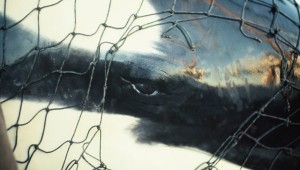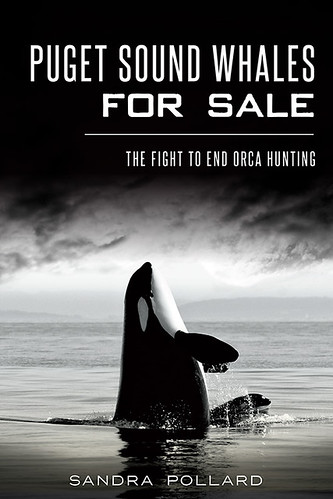
By: Ashley Ahearn, KUOW
The resident killer whales of Puget Sound are an endangered species. There are about 80 of them left.
But there was a time, not too long ago, when people were catching these whales and selling them into captivity.
In the 1960s and ‘70s an estimated 35 orcas were taken from Puget Sound. 13 were killed in the process.
Sandra Pollard has documented the history of orca capture in Puget Sound in a new book: Puget Sound Whales For Sale: The Fight To End Orca Hunting.
She spoke with EarthFix’s Ashley Ahearn about this dark period in orca history.
Ashley Ahearn: Let’s go back in time here a little bit, why did people start catching orcas?
Sandra Pollard: I think there was probably an element of the trophy hunter there but also they didn’t like whales very much in those days, particularly the orcas, because they thought they were taking the salmon. And in the ‘60s the Navy used them as target practice for strafing runs and many of the whales that eventually turned up in marine parks had bullet holes in them.
So they were not respected. They were disliked. The people who did revere and respect them were the Native American people and they’re on their tribal crests and they looked up to them and they still do.
Ahearn: So it’s been almost 50 years since the first captive orca arrived in Seattle. Can you tell me about that whale and what happened, what was his story?
Pollard: That’s correct. The first whale was called Namu and a man called Ted Griffin had an aquarium down in Seattle, the Seattle Marine Aquarium, and he’d always wanted to have a killer whale and two whales actually washed up in British Columbia at Warrior Cove. They got caught in nets when a couple of fishermen abandoned their nets to get away from a storm. So they had two whales up there. One a bull and one a calf. The calf escaped but unfortunately the bull did not.
So Ted Griffin flew up to Warrior Cove and secured the whale, but then of course, he had to get it back to Seattle. So, with the help of fishermen, he built a three-sided pen with a net on one side and steel bars on the other and they brought Namu, as he was then called, down to Seattle in that three-sided pen. That was a 400-mile journey which took 18 days, and made a glorious entrance into Seattle to go-go dancers and great jubilation. But at the same time there were people there who didn’t like what they were seeing and there were protesters waiting with “Save The Whales” signs even back then. But that was how it all started.
Ahearn: And there was a Canadian biologist who went along for the trip and he describes the separation of Namu from his family. Can you read that section?
Pollard: Yes. The biologist was called Gil Hewlett and this is what he had to say.
“When they are within 300 yards of the pen, Namu lets out a terrifying squeal, almost like a throttled cat. He leaps out of the water and crashes against the left corner of the pen. There is terrific thrashing and he is making all kinds of sounds. Then they are there again, the same family of the cow and two calves. They came straight up behind the pen to about 10 feet away, tremendous squealing going on. Namu seemed to lose all coordination in the pen. He kept getting swept against the cargo net and swimming vigorously forward. The family unit circles around towards the end of the pen.”
Ahearn: Now the family unit follows him a certain distance but then they stop. What happens?
Pollard: Yes the female and the two calves follow him to an area called Seymour Narrows up in British Columbia near Campbell River and then they gradually fell back. And it has been found that the Seymour Narrows area is really the dividing line between the northern residents and the southern residents.
Ahearn: What was the public sentiment around orcas that were being captured and taken into captivity for entertainment? How were people responding at the time?
Pollard: For the most part I think they were thrilled to see this exotic creature up close and personal and impressed by the abilities it had because they are such intelligent creatures that they learn tricks for food. But I think the general consensus was more one of wonder. But there were still those creeping suspicions that this wasn’t right.
Ahearn: It seems that in terms of public sentiment changing about orca capture the most notorious, the most well known capture, occurred in Penn Cove on Whidbey Island in 1970. Can you tell me what happened on that day?
Pollard: That was on either August the 7th or 8th, 1970 and the three pods of Southern Resident orcas known as J,K and L were going north, probably back to the San Juan Islands, and Ted Griffen and Don Goldsbury and the capture team they went out in boats and started to turn them back towards Whidbey Island and the idea was to drive them into Holmes Harbor, which is a sheltered place on Whidbey Island. And they used seal bombs, which are loud explosive devices. And they also used buzzing aircraft.
But they didn’t get them into Holmes Harbor. The whales are very clever and they brought in their diversionary tactics. The mothers and the calves headed up for Deception Pass and the males did a decoy action by going in the opposite direction. But it was too late. The boats outstripped them and they turned the mothers and the calves back and drove about 100 whales into Penn Cove on Whidbey Island. And they were held there in nets until they went through the selection process, which would be to corral the mothers away from the calves and split them up, because it was the calves that they wanted. They were smaller. They easier to transport. And they were easier to train.
The capture net pens in Penn Cove on Whidbey Island 1970.
And the rest of the whales that were turned away that they didn’t want, they stayed around. They’re a family unit. They’re highly social and they stay together for life. There is no dispersal, other than by death or human interference. So those whales stayed with the whales in the capture pens and eventually seven whales were selected for marine parks, which were already waiting around the world. Four calves were drowned and there also had been a female who had died. She had charged the net to try to get to her calf, so she also died during the process, as well. And this caused an uproar and a lot of feeling against the captures. And that started to be the turning point.
And the last whale to be taken from Penn Cove was Lolita and she remains at the Miami Seaquarium where she has been for 44 years.
Ahearn: Sandra, when did we stop taking orcas out of Puget Sound to sell to marine parks around the world?
Pollard: We stopped doing that in March, 1976 when six orca were driven into Olympia and the seal bombs were used and it caused a great hue and cry. There were protesters on the water. There were protesters on land. And there was a lawsuit, as well. So after a couple of weeks there were only two whales left because three had escaped. One had been turned away because it was too big and the two whales were turned over to the University of Washington to be radio tagged and tracked for as long as possible. I don’t think they were tracked for very long, but there was a lawsuit which stopped the captures in Washington state and Seaworld were not able to come back into Washington state and capture orca again and that was the last capture in Washington state.
Ahearn: So really the end of a very dark era for the orca in Puget Sound.
Pollard: It certainly was. And one wonders if that hadn’t happened how much longer the captures would have continued and how many more whales we would have lost.
Sandra Pollard is the author of Puget Sound Whales for Sale: The Fight To End Orca Hunting. You can find out about upcoming stops on her Northwest book tour here.

